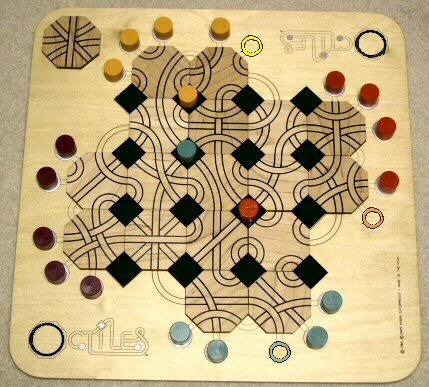

|
Octiles: |
 |
|
Octiles on deluxe wood board, laser-engraved with handpainted trim, was designed and introduced in honor of its 25th Anniversary, 1984-2009. It replaced the original "classic" edition played on a white leather-like vinyl mat. The deluxe wood stores in a velvet satchel with carry handles; a separate felt pouch has pockets for game pieces. The 16 little square islands (the felt-padded "stops" where runners land) are affixed to the board, no separate installation required. The 18 laser-engraved wood octagons come from a single piece of premium birch plywood, lovingly sealed and finished with handrubbed tung oil. Watch how their shimmer shifts as you turn them eight different ways. Simply beautiful, and beautifully challenging. It belongs in every game lover's collection.
How to play Octiles "Move Over" version Start: Players choose their colors and set their five runners on the starting circles nearest to themselves. Stack the 18 tiles in random order, face-up, in a single tower just off the board. Play: Players take turns placing the top tile from the stack onto the board and then moving one of their runners across that tile. The tile may form part of a longer path.
Movement: Runners move along the paths crossing the tiles. They always go all the way across a tile. Where paths cross, they are underpasses and overpasses, not blocks. Where tile edges meet or are extended by external detours printed on the board, the path is continuous. A path stops only at circles — the felt-covered spaces ("stops") between tiles, and the finish circles on the opposite side of the board.
Special conditions: At least one of a player's starting circles must be left open at the end of a turn. If no circle is open, the player must place a tile so that a runner can move out.
Two other, more complex, game versions are included in the Octiles rule book, plus 29 solitaire challenges. In "Octiles" the goal is the same as for "Move Over" but you do only one of these on a turn: move a runner, replace a tile, or rotate a tile. In "Team Up" you aim to bring your five runners from a widely separated start into a directly connected group, without breaking already formed connections. Fascinating! |